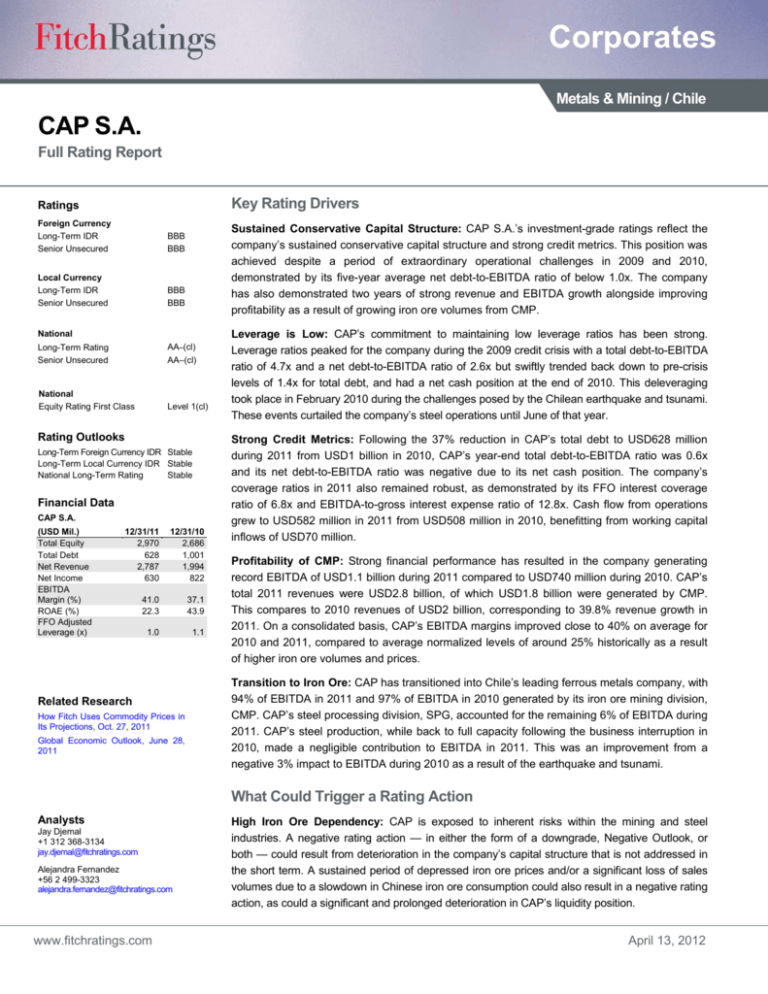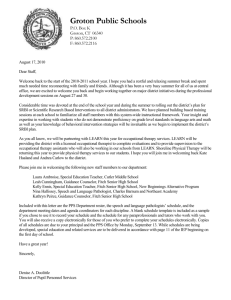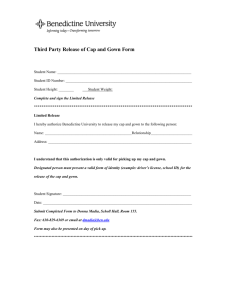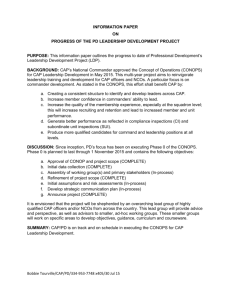
Corporates
Metals & Mining / Chile
CAP S.A.
Full Rating Report
Key Rating Drivers
Ratings
Foreign Currency
Long-Term IDR
Senior Unsecured
BBB
BBB
Local Currency
Long-Term IDR
Senior Unsecured
BBB
BBB
Sustained Conservative Capital Structure: CAP S.A.’s investment-grade ratings reflect the
company’s sustained conservative capital structure and strong credit metrics. This position was
achieved despite a period of extraordinary operational challenges in 2009 and 2010,
demonstrated by its five-year average net debt-to-EBITDA ratio of below 1.0x. The company
has also demonstrated two years of strong revenue and EBITDA growth alongside improving
profitability as a result of growing iron ore volumes from CMP.
National
AA–(cl)
Long-Term Rating
Senior Unsecured
AA–(cl)
National
Equity Rating First Class
Level 1(cl)
Rating Outlooks
Long-Term Foreign Currency IDR Stable
Long-Term Local Currency IDR Stable
National Long-Term Rating
Stable
Financial Data
CAP S.A.
(USD Mil.)
Total Equity
Total Debt
Net Revenue
Net Income
EBITDA
Margin (%)
ROAE (%)
FFO Adjusted
Leverage (x)
12/31/11
2,970
628
2,787
630
12/31/10
2,686
1,001
1,994
822
41.0
22.3
37.1
43.9
1.0
1.1
Related Research
How Fitch Uses Commodity Prices in
Its Projections, Oct. 27, 2011
Global Economic Outlook, June 28,
2011
Leverage is Low: CAP’s commitment to maintaining low leverage ratios has been strong.
Leverage ratios peaked for the company during the 2009 credit crisis with a total debt-to-EBITDA
ratio of 4.7x and a net debt-to-EBITDA ratio of 2.6x but swiftly trended back down to pre-crisis
levels of 1.4x for total debt, and had a net cash position at the end of 2010. This deleveraging
took place in February 2010 during the challenges posed by the Chilean earthquake and tsunami.
These events curtailed the company’s steel operations until June of that year.
Strong Credit Metrics: Following the 37% reduction in CAP’s total debt to USD628 million
during 2011 from USD1 billion in 2010, CAP’s year-end total debt-to-EBITDA ratio was 0.6x
and its net debt-to-EBITDA ratio was negative due to its net cash position. The company’s
coverage ratios in 2011 also remained robust, as demonstrated by its FFO interest coverage
ratio of 6.8x and EBITDA-to-gross interest expense ratio of 12.8x. Cash flow from operations
grew to USD582 million in 2011 from USD508 million in 2010, benefitting from working capital
inflows of USD70 million.
Profitability of CMP: Strong financial performance has resulted in the company generating
record EBITDA of USD1.1 billion during 2011 compared to USD740 million during 2010. CAP’s
total 2011 revenues were USD2.8 billion, of which USD1.8 billion were generated by CMP.
This compares to 2010 revenues of USD2 billion, corresponding to 39.8% revenue growth in
2011. On a consolidated basis, CAP’s EBITDA margins improved close to 40% on average for
2010 and 2011, compared to average normalized levels of around 25% historically as a result
of higher iron ore volumes and prices.
Transition to Iron Ore: CAP has transitioned into Chile’s leading ferrous metals company, with
94% of EBITDA in 2011 and 97% of EBITDA in 2010 generated by its iron ore mining division,
CMP. CAP’s steel processing division, SPG, accounted for the remaining 6% of EBITDA during
2011. CAP’s steel production, while back to full capacity following the business interruption in
2010, made a negligible contribution to EBITDA in 2011. This was an improvement from a
negative 3% impact to EBITDA during 2010 as a result of the earthquake and tsunami.
What Could Trigger a Rating Action
Analysts
Jay Djemal
+1 312 368-3134
jay.djemal@fitchratings.com
Alejandra Fernandez
+56 2 499-3323
alejandra.fernandez@fitchratings.com
www.fitchratings.com
High Iron Ore Dependency: CAP is exposed to inherent risks within the mining and steel
industries. A negative rating action — in either the form of a downgrade, Negative Outlook, or
both — could result from deterioration in the company’s capital structure that is not addressed in
the short term. A sustained period of depressed iron ore prices and/or a significant loss of sales
volumes due to a slowdown in Chinese iron ore consumption could also result in a negative rating
action, as could a significant and prolonged deterioration in CAP’s liquidity position.
April 13, 2012
Corporates
Liquidity and Debt Structure
Robust Liquidity and Low Debt
CAP’s credit profile is bolstered by its robust liquidity position. For 2011, the company held
cash and marketable securities of USD883 million compared to total debt of USD628 million.
Total debt decreased following the redemption of two local and one international bond issues.
At year-end 2011, CAP’s debt was composed of bank loans (62%), local bonds (27%), and
international bonds (11%).
Comfortable Debt Amortization Schedule
During the next three years, CAP has USD86 million of debt maturities due with USD16 million
due in 2012, USD11 million due in 2013, and USD59 million due in 2014. Cash to short-term
debt is therefore strong at 7.3x. CAP also has access to additional credit lines with local banks,
should they be required.
Covenant Headroom
CAP has debt covenant requirements for its bank debt facilities and comfortably met the
quarterly test requirements over the past year, with net financial debt to EBITDA below the
threshold of 4.0x, and EBITDA to net financial expenses over 2.5x. Fitch’s financial projections
for CAP indicate that the company will continue to meet its covenant requirements comfortably
during the next four years.
CAP also has relatively small derivative exposure positions, with a cross currency swap
amounting to USD44 million and forward CLP/USD derivatives totaling USD271 million, with
both maturing in 2012. In addition, the company holds an interest rate swap of USD172 million
that matures during May 2018.
Total Debt and Leverage Ratio
(Years Ended Dec. 31)
Total Debt
Debt/EBITDA
(x)
(USD Mil.)
1,000
5
800
4
600
3
400
2
200
1
0
0
2007
2008
2009
2010
2011
Source: CAP S.A.
Recent Financial Performance
Record EBITDA Generation due to Iron Ore
Related Criteria
Corporate
Rating
Aug. 12, 2011
Methodology,
Parent
and
Subsidiary
Linkage, Aug. 12, 2011
Rating
National Ratings Criteria, Jan. 19,
2011
CAP S.A.
April 13, 2012
CAP’s consolidated revenues, fuelled by the increasing iron ore production at CMP, grew to
USD2.8 billion in 2011 from USD1.9 billion in 2010, a 40% year-on-year increase. Accordingly,
EBITDA generated was a record USD1.1 billion in 2011 compared to the previous record of
USD740 million in 2010. Due to the high profitability of the iron ore division, the company’s
consolidated EBITDA margin grew to 41% for 2011 from 37% in 2010.
2
Corporates
CAP S.A. Net Sales by
Business Unit
(Full Year 2011)
CMP
48%
SPG
17%
In 2011, the average price for iron ore sold by CMP was USD154 per metric ton based on
sales volumes of 11.5 million metric tons. This compares favorably to CMP’s average cost of
production of about USD50 per metric ton for the year. The average price for steel sold by CSH
was USD883 per metric ton based on sales volumes of 1.1 million metric tons, with SPG
achieving average prices of USD1,252 per metric ton based on sales volumes of 370,000
metric tons for 2011.
Imports Erode Steel Profitability
CSH
35%
CSH had a neutral contribution to CAP’s consolidated EBITDA during 2011, following a
negative 3% contribution in 2010. The loss in steel business profitability during 2011 was due
to increased raw material and energy costs and the strategy to compete with cheap steel
imports.
Source: CAP S.A.
CAP S.A. EBITDA by
Business Unit
(Full Year 2011)
CSH
0%
CMP
94%
SPG
6%
Robust Cash Flow Generation
The company generated USD583 million of CFFO in 2011, following a working capital inflow of
USD70 million from FFO of USD512 million. This compares to CFFO of USD508 million in
2010. FCF for 2011 was negative USD22 million following capex of USD282 million and
dividend payments of USD322 million.
Source: CAP S.A.
CAP S.A. Total Steel Market
Share
(Full Year 2011)
Rest of
Chilean
Market
53%
CAP
S.A.
47%
Source: CAP S.A.
Historically, the company has demonstrated discipline with regards to dividend payments when
operating conditions require more liquidity, as seen with the low dividend of USD94 million
during difficult operating conditions of 2009. CAP is also able to scale back or delay its sizeable
capex to bolster cash flow over the next two years, if required.
CAP’s actual FCF generated for 2011 was better than Fitch’s previous expectations of negative
USD109 million for the year. Fitch expects the company to return to positive FCF generation in
2012 compared to previous expectations of 2013, subject to dividends. CAP traditionally
exhibits strong FCF during normal investment periods.
Cash Flow to fund Capex
Fitch expects CAP to finance its sizeable capital expenditure plans of USD783 million and
USD718 million in 2012 and 2013, respectively, mostly from internal cash flow, enabling the
company to maintain its conservative capital structure. This capex relates mainly to CMP’s
projects to increase iron ore production to over 18 million metric tons per year by 2015 from
around 12 million metric tons. During 2011, the company’s FCF was negative USD22 million
following capex of USD282 million and dividends of USD322 million.
CAP S.A. Average Steel
Prices
1,200
1,000
800
600
400
200
0
These imports flooded Chile’s domestic market as a result of its open free trade agreements
and strong currency, bolstered by the strong sentiment for copper globally. By adopting this
competitive strategy, CAP has been able to recover its leading steel market share following the
loss in market share during 2010 due to its operations being offline for half of the year.
(USD per Metric Ton)
Company Overview
2012E 2011
2010
2009
2008
Market Leader in Ferrous Metals
Source: CAP S.A.
CAP has a 60% domestic market share in its target steel markets and a 47% total steel market
share during 2011. CMP has a dominant position in Chilean iron ore mining, with close to
CAP S.A.
April 13, 2012
3
Corporates
11.5 million metric tons of iron ore shipped in 2011 compared to 10.2 million metric tons in
2010, and projections of over 12 million metric tons for 2012.
During 2011, 16% of CMP’s iron ore was destined for internal consumption in Chile, with 64%
of production exported to China. The company’s solid financial performance during 2011 was
mainly due to higher shipment volumes and robust prices for iron ore.
CAP, through its steel subsidiary, CSH, produces both flat steel products (46%) and long steel
products (54%). Chilean apparent steel consumption grew at an average annual rate of 5.5%
over the last 20 years. During 2011, total Chilean steel consumption was 2.5 million metric
tons. The growth rate of apparent steel consumption per capita was 4% between 1988 and
2008, with GDP per capita growing at an average rate of 6.5% over the same period. Fitch
calculates that GDP in Chile will grow by 3.7% in 2012 and 4.5% in 2013.
CAP S.A.
April 13, 2012
4
Corporates
Financial SummaryCAP S.A.
(IFRS, USD Mil., Years Ended Dec. 31)
Profitability
Operating EBITDA
Operating EBITDAR
Operating EBITDA Margin (%)
Operating EBITDAR Margin (%)
FFO Return on Adjusted Capital (%)
Free Cash Flow Margin (%)
Return on Average Equity (%)
Coverage (x)
FFO Interest Coverage
Operating EBITDA/Gross Interest Expense
Operating EBITDAR/(Interest Expense + Rental Expenses)
Operating EBITDA/Debt Service Coverage
Operating EBITDAR/Debt Service Coverage
FFO Fixed-Charge Coverage
FCF Debt Service Coverage
(Free Cash Flow + Cash and Marketable Securities)/Debt Service Coverage
Cash Flow from Operations/Capital Expenditures
Capital Structure and Leverage (x)
FFO Adjusted Leverage
Total Debt with Equity Credit/Operating EBITDA
Total Net Debt with Equity Credit/Operating EBITDA
Total Adjusted Debt/Operating EBITDAR
Total Adjusted Net Debt/Operating EBITDAR
Implied Cost of Funds (%)
Secured Debt/Total Debt
Short-Term Debt/Total Debt
Balance Sheet
Total Assets
Cash and Marketable Securities
Short-Term Debt
Long-Term Debt
Total Debt
Equity Credit
Total Debt with Equity Credit
Off-Balance Sheet Debt
Total Adjusted Debt with Equity Credit
Total Equity
Total Adjusted Capital
Cash Flow
Funds from Operations
Change in Working Capital
Cash Flow from Operations
Total Non-Operating/Nonrecurring Cash Flow
Capital Expenditures
Dividends
Free Cash Flow
Net Acquisitions and Divestitures
Other Investments, Net
Net Debt Proceeds
Net Equity Proceeds
Other, Financing Activities
Total Change in Cash
Income Statement
Net Revenue
Revenue Growth (%)
Operating EBIT
Gross Interest Expense
Rental Expense
Net Income
2011
2010
2009
2008
2007
2006
1,143
1,143
41.0
41.0
16.7
(0.8)
22.3
740
740
37.1
37.1
24.8
7.3
43.9
187
187
13.5
13.5
7.3
3.7
(1.4)
532
532
27.0
27.0
22.1
(1.2)
27.6
333
333
21.1
21.1
18.1
(7.5)
26.2
251
251
25.2
25.2
15.3
(2.3)
22.6
6.8
12.8
12.8
5.4
5.4
6.8
0.3
4.5
2.1
14.1
11.4
11.4
2.6
2.6
14.1
0.7
2.2
2.5
2.4
3.3
3.3
1.8
1.8
2.4
1.1
4.9
2.0
7.7
9.2
9.2
3.1
3.1
7.7
0.2
2.4
1.7
6.2
7.1
7.1
2.6
2.6
6.2
(0.6)
0.9
0.9
7.3
8.3
8.3
2.0
2.0
7.3
0.1
2.0
1.5
1.0
0.5
(0.2)
0.5
(0.2)
10.9
0.2
1.1
1.4
0.8
1.4
0.8
6.9
0.2
6.2
4.6
2.6
4.6
2.6
6.6
0.1
2.0
1.7
0.9
1.7
0.9
7.7
0.1
2.1
1.9
1.3
1.9
1.3
7.4
0.1
2.9
2.5
1.6
2.5
1.6
5.8
0.2
4,771
883
121
507
628
0
628
0
628
2,970
3,598
4,870
429
219
782
1,001
0
1,001
0
1,001
2,686
3,687
2,414
387
44
826
870
0
870
0
870
1,060
1,930
2,485
379
111
769
880
0
880
0
880
1,134
2,014
2,050
184
80
541
622
0
622
0
622
987
1,609
1,772
242
97
539
636
0
636
0
636
815
1,451
512
70
583
0
(282)
(322)
(22)
2
(47)
(258)
32
(1)
(295)
848
(340)
508
0
(207)
(155)
146
4
(363)
65
401
(24)
229
83
204
287
0
(142)
(94)
51
106
(3)
(90)
0
27
91
387
(120)
267
0
(161)
(130)
(25)
(238)
(6)
257
0
(7)
(19)
244
45
289
0
(309)
(98)
(118)
252
0
(51)
1
4
88
192
(12)
180
0
(119)
(84)
(23)
(23)
(1)
133
0
1
88
2,787
39.8
979
89
0
630
1,994
43.8
638
65
0
822
1,386
(29.7)
54
57
0
(15)
1,972
24.8
347
58
0
293
1,580
58.4
210
47
0
236
997
13.4
135
30
0
165
Source: Fitch calculations using CAP S.A.’s consolidated financial statements.
CAP S.A.
April 13, 2012
5
Corporates
The ratings above were solicited by, or on behalf of, the issuer, and therefore, Fitch has been
compensated for the provision of the ratings.
ALL FITCH CREDIT RATINGS ARE SUBJECT TO CERTAIN LIMITATIONS AND DISCLAIMERS. PLEASE READ THESE
LIMITATIONS
AND
DISCLAIMERS
BY
FOLLOWING
THIS
LINK:
HTTP://FITCHRATINGS.COM/UNDERSTANDINGCREDITRATINGS. IN ADDITION, RATING DEFINITIONS AND THE
TERMS OF USE OF SUCH RATINGS ARE AVAILABLE ON THE AGENCY'S PUBLIC WEB SITE AT
WWW.FITCHRATINGS.COM. PUBLISHED RATINGS, CRITERIA, AND METHODOLOGIES ARE AVAILABLE FROM
THIS SITE AT ALL TIMES. FITCH'S CODE OF CONDUCT, CONFIDENTIALITY, CONFLICTS OF INTEREST, AFFILIATE
FIREWALL, COMPLIANCE, AND OTHER RELEVANT POLICIES AND PROCEDURES ARE ALSO AVAILABLE FROM
THE CODE OF CONDUCT SECTION OF THIS SITE.
Copyright © 2012 by Fitch, Inc., Fitch Ratings Ltd. and its subsidiaries. One State Street Plaza, NY, NY 10004.Telephone:
1-800-753-4824, (212) 908-0500. Fax: (212) 480-4435. Reproduction or retransmission in whole or in part is prohibited except
by permission. All rights reserved. In issuing and maintaining its ratings, Fitch relies on factual information it receives from
issuers and underwriters and from other sources Fitch believes to be credible. Fitch conducts a reasonable investigation of the
factual information relied upon by it in accordance with its ratings methodology, and obtains reasonable verification of that
information from independent sources, to the extent such sources are available for a given security or in a given jurisdiction.
The manner of Fitch’s factual investigation and the scope of the third-party verification it obtains will vary depending on the
nature of the rated security and its issuer, the requirements and practices in the jurisdiction in which the rated security is offered
and sold and/or the issuer is located, the availability and nature of relevant public information, access to the management of the
issuer and its advisers, the availability of pre-existing third-party verifications such as audit reports, agreed-upon procedures
letters, appraisals, actuarial reports, engineering reports, legal opinions and other reports provided by third parties, the
availability of independent and competent third-party verification sources with respect to the particular security or in the
particular jurisdiction of the issuer, and a variety of other factors. Users of Fitch’s ratings should understand that neither an
enhanced factual investigation nor any third-party verification can ensure that all of the information Fitch relies on in connection
with a rating will be accurate and complete. Ultimately, the issuer and its advisers are responsible for the accuracy of the
information they provide to Fitch and to the market in offering documents and other reports. In issuing its ratings Fitch must rely
on the work of experts, including independent auditors with respect to financial statements and attorneys with respect to legal
and tax matters. Further, ratings are inherently forward-looking and embody assumptions and predictions about future events
that by their nature cannot be verified as facts. As a result, despite any verification of current facts, ratings can be affected by
future events or conditions that were not anticipated at the time a rating was issued or affirmed.
The information in this report is provided “as is” without any representation or warranty of any kind. A Fitch rating is an opinion
as to the creditworthiness of a security. This opinion is based on established criteria and methodologies that Fitch is
continuously evaluating and updating. Therefore, ratings are the collective work product of Fitch and no individual, or group of
individuals, is solely responsible for a rating. The rating does not address the risk of loss due to risks other than credit risk,
unless such risk is specifically mentioned. Fitch is not engaged in the offer or sale of any security. All Fitch reports have shared
authorship. Individuals identified in a Fitch report were involved in, but are not solely responsible for, the opinions stated therein.
The individuals are named for contact purposes only. A report providing a Fitch rating is neither a prospectus nor a substitute for
the information assembled, verified and presented to investors by the issuer and its agents in connection with the sale of the
securities. Ratings may be changed or withdrawn at anytime for any reason in the sole discretion of Fitch. Fitch does not
provide investment advice of any sort. Ratings are not a recommendation to buy, sell, or hold any security. Ratings do not
comment on the adequacy of market price, the suitability of any security for a particular investor, or the tax-exempt nature or
taxability of payments made in respect to any security. Fitch receives fees from issuers, insurers, guarantors, other obligors,
and underwriters for rating securities. Such fees generally vary from US$1,000 to US$750,000 (or the applicable currency
equivalent) per issue. In certain cases, Fitch will rate all or a number of issues issued by a particular issuer, or insured or
guaranteed by a particular insurer or guarantor, for a single annual fee. Such fees are expected to vary from US$10,000 to
US$1,500,000 (or the applicable currency equivalent). The assignment, publication, or dissemination of a rating by Fitch shall
not constitute a consent by Fitch to use its name as an expert in connection with any registration statement filed under the
United States securities laws, the Financial Services and Markets Act of 2000 of Great Britain, or the securities laws of any
particular jurisdiction. Due to the relative efficiency of electronic publishing and distribution, Fitch research may be available to
electronic subscribers up to three days earlier than to print subscribers.
CAP S.A.
April 13, 2012
6







